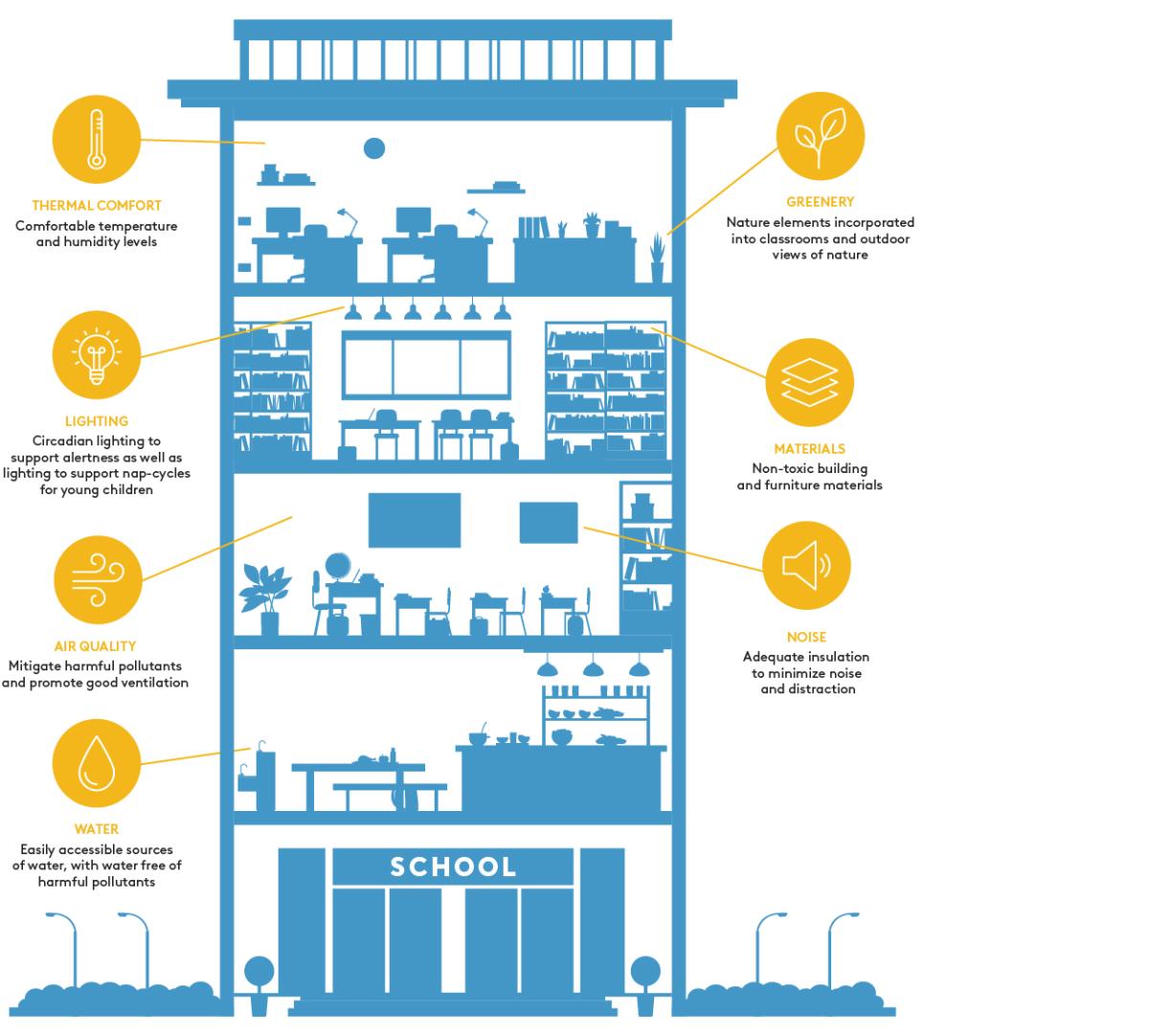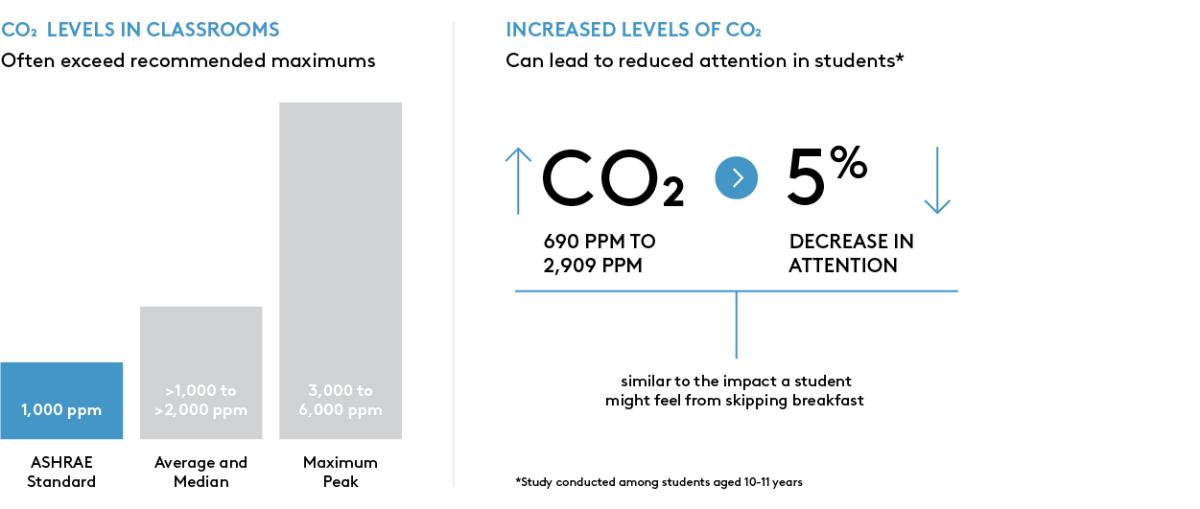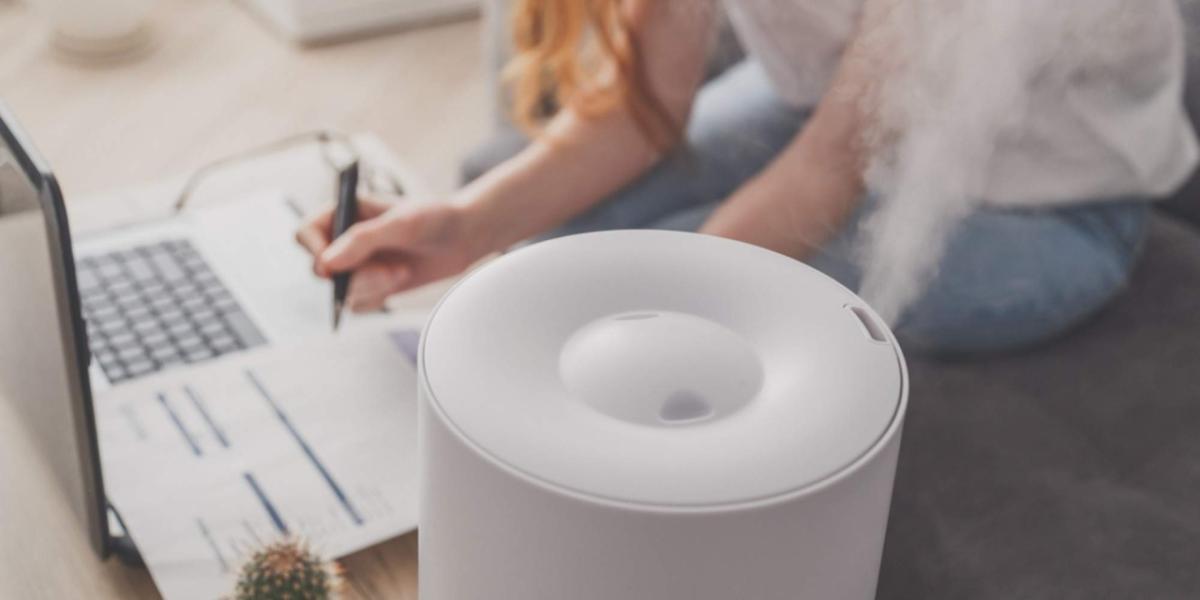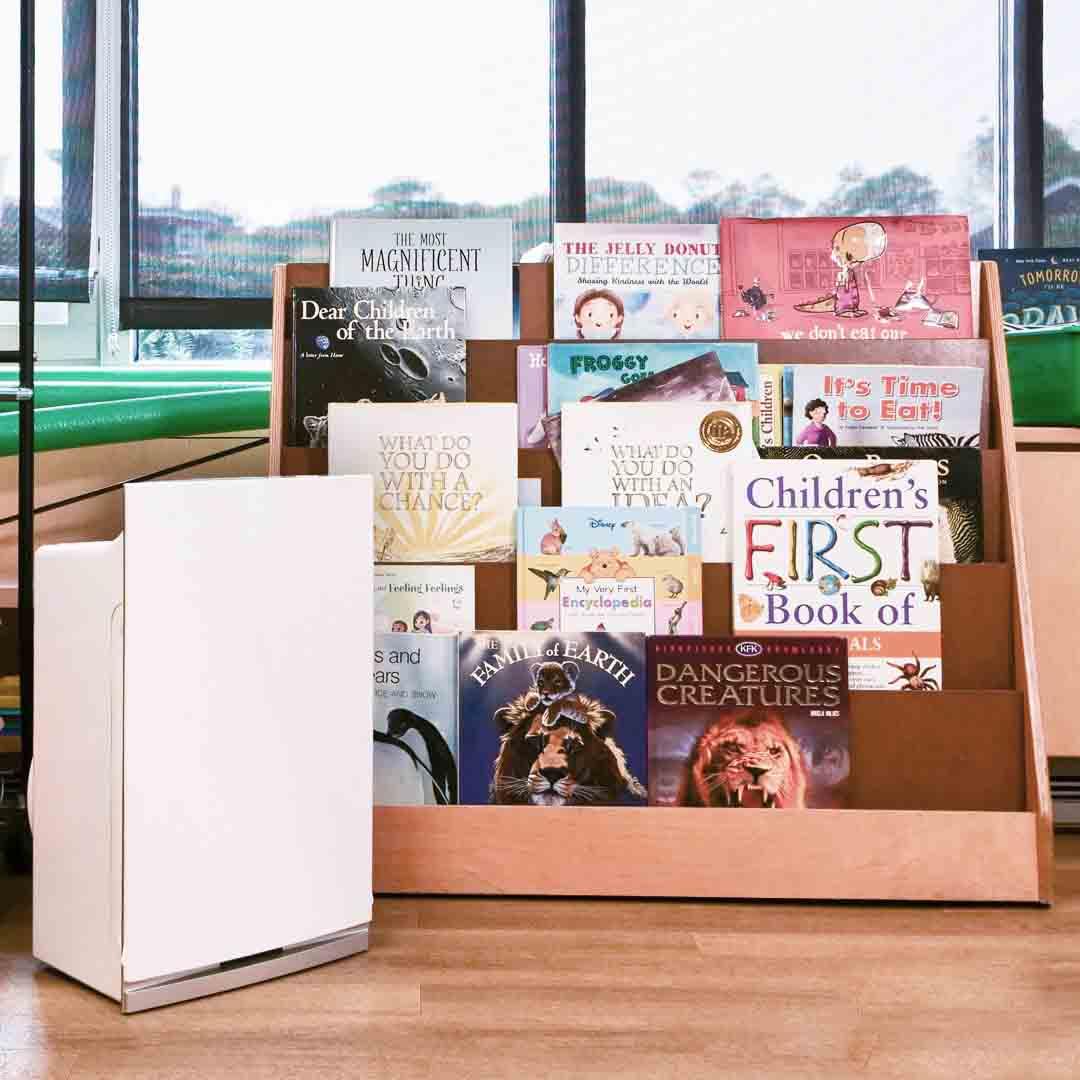How To Create a Healthy School Environment
This article looks at 7 key components of healthy school environments and emerging scientific insights on how our physical environments affect students’ health and academic performance.
How To Create a Healthy School Environment
How To Create an Optimal School Environment for Student and Staff Well-Being
Children in the U.S. spend about six hours per day or 1,000 hours per year in school, during a time of life when they are more sensitive to environmental influences. However, many school buildings are old and not up to date — resulting in substandard conditions and environments that fail to help students thrive. Leveraging physical environments and implementing preventive interventions can help make schools healthier.
Delos recognizes this as a tremendous opportunity to support the health of students, educators and staff — with profound societal impacts both today and in the future. In this article, we aim to address two main questions:
-
What factors can impact learning environments?
-
How can healthier spaces — and behaviors inside them — help position students and staff for success?
As schools have been navigating the Covid-19 pandemic and attempting to prevent its spread over the past two years, the indoor environment has become front and center in efforts to mitigate risk beyond Covid.
This resource provides an overview of healthy school environments and emerging scientific insights on how physical environments can affect students’ health and academic performance. In addition, we highlight social and psychological factors that can impact students’ success. Finally, we offer evidence-based strategies that can be implemented in prekindergarten (pre-K), school and university buildings to promote health and well-being for all.
The State of School Facilities Today
There are around 137,000 educational institutions in the U.S. today. By the time a typical student graduates from high school, they will have spent more than 15,000 hours of their life in school. In the 2020-2021 academic year, approximately 56.6 million students are projected to attend pre-K through high school, and 19.7 million are estimated to be enrolled in higher education institutions.
Yet most of these students spend this significant period of time in conditions that are not conducive to their health and performance. This is all the more concerning because during early childhood, a rapid and extensive development of organs and systems takes place, while natural defenses against potential toxins are less developed — which makes this period disproportionately important to a child’s future health. As of 2012, the average age of U.S. public school buildings was 44 years and the average age since renovation was 12 years. Buildings that are old are more likely to have issues that can negatively impact student health: they may not adhere to more recent building standards and best practices, and conditions can deteriorate without extensive preventive maintenance.
7 Environmental Factors Affecting Student Health and Academic Performance and Strategies to Address Them
The health of students, teachers and staff can be affected by myriad factors found at school, from indoor air quality (IAQ) to lighting, to material composition and noise levels. This overview highlights some of the key factors that can affect health and academic performance in learning environments.
With a focus on indoor environmental quality (IEQ) and science-informed methods, schools can create comprehensive strategies to cultivate student health and well-being. This approach can serve as a framework for learning throughout and following the Covid-19 pandemic. Utilizing research, lessons learned and opportunities to reframe learning environments, these measures will provide guidance for environmental and behavioral school improvements.
1. Indoor Air Quality
Infiltration of outdoor pollution such as particulate matter, allergens and mold, as well as indoor-generated pollutants such as carbon dioxide all pose health risks that require prevention or mitigation.
Yet, many schools are not equipped to manage these risks: an estimated 41% of school districts need to update or replace heating, ventilation and air conditioning (HVAC) systems in at least half of their schools, representing about 36,000 public schools (grades K-12) nationwide.
-
Enhance Ventilation: Ventilation systems can play an important role in diluting pollutant concentrations that have built up indoors by bringing in fresh air from the outdoors. Studies of schoolchildren show that greater ventilation – achieved by increasing the outdoor air supply – can meaningfully improve academic performance, at relatively low energy and capital costs. One study found that doubling the outdoor air supply rate to classrooms improved the speed of schoolwork performance by about 8%.
-
Filtered Air: Breathing cleaner air can have a meaningful impact on student and staff health, performance and overall well-being. Air purifiers can help reduce the concentration of pollutants indoors by actively filtering indoor air. One study found that using four portable air purifiers in a school classroom reduced the concentration of aerosols by over 90% within a 30 minute period (with an air exchange rate 5.5 h−1), compared with a neighboring classroom without air purifiers.
Different air purification technologies can target different types of pollutants. Delos’ Advanced Air Purification solutions leverage disinfecting filtration system (DFS) technology and are capable of capturing and removing particles down to 0.007 microns—smaller than the virus that causes Covid-19 —at 99.99% aggregate efficiency.*
-
Monitor Indoor Air Quality: An indoor air quality monitor can help track particulate matter pollution and other air quality parameters across the school. Depending on the indoor air quality issues identified, schools can work to determine what remediation efforts are needed to optimize their air quality. Many consumer-grade, easy-to-use monitors are available online.
-
Monitor Outdoor Air Quality: Because outdoor air pollutants can easily get inside (e.g., through open windows and doors and/or cracks in walls, doors and window sealants), it is important to stay informed about local outdoor air quality through real-time monitoring resources. Check resources like AirNow or Breezometer for real-time outdoor air quality information. If the outdoor air quality is poor, keep all classroom windows closed and close the fresh-air intake of the AC unit.
2. Water Access and Quality
Even mild to moderate dehydration can lead to impaired performance in tasks that require attention, psychomotor and memory skills.
And while it's important for students to have sufficient access to drinking water, it's also important for that water to be free of harmful pollutants. Contaminants, such as lead, have been linked to behavior and learning problems, lower IQ and hyperactivity, slowed growth and anemia among children.
-
Improve Access to Drinking Water: It is important to ensure that clean, free drinking water is readily available to students throughout the school. Depending on the school’s particular needs, schools can help improve water access by installing more water fountains, water coolers, water bottle refilling stations and other clean drinking water sources.
-
Conduct Regular Water Quality Testing: Conducting regular water quality testing is essential to ensuring students’ access to safe drinking water. Twenty-four U.S. states and the District of Columbia had lead testing programs for school drinking water as of 2018.
-
Conduct Regular Maintenance: Ensure that drinking water access points (such as water fountains) are well-maintained and cleaned regularly. This helps to reduce possible bacterial contamination and also makes drinking water stations more appealing to students.
-
Filter Water: Filtration is one of the most effective treatment methods for mitigating water quality concerns. Different types of filters are designed for different types of contaminants. Water filters should be selected based on the specific water quality concerns in a given school.
-
Soften Water: “Hard water,” or water that contains excessive minerals such as calcium, can sometimes taste “off.” This can discourage children from drinking enough water. Water softeners that filter out these minerals can help improve the taste and appearance of water.
3. Lighting
The lighting that students are exposed to during the school day can affect their health, well-being, performance and sleep. Good quality lighting is important so that schoolchildren can properly see and read the materials presented and taught to them. But lighting may also affect children’s academic outcomes through circadian pathways that support alertness and cognitive performance.
-
Use Tunable Lighting: Specialized lighting fixtures and controls can make indoor electric lighting adjustable. Utilize light that resembles natural daylight (brighter, cooler-toned light) during the daytime to support alertness and cognitive performance.
-
Open Window Shades: Maximize natural daylight, but also be sure to close shades to regulate daylight exposure during naptime (for pre-K students).
-
Improve Safety: Good lighting helps students feel safer at school and can reduce violence. Research has shown that there is an indirect association between illumination and violence in educational settings, where illuminated non-classroom areas may serve as a deterrent to bad behavior through an increased awareness of consequences due to bad behaviors being more visible.
4. Thermal Environment
Young children are more vulnerable to the effects of extreme temperatures and ambient humidity levels. Both temperature and humidity greatly influence our thermal comfort. Temperatures that are too hot or too cold, and humidity that is too high or too low, can be detrimental to our health; furthermore, students cannot perform at their best if they are not thermally comfortable. Studies have consistently shown that children prefer cooler environments and are particularly vulnerable to the effects of higher temperatures, which in turn can impact their performance in school.
In fact, a study of 75,000 high school students in New York City found that students were 12.3% more likely to fail an exam on a 90°F (32°C) day versus a 75°F (24°C) day.
-
Invest in Reliable Heating and Cooling Systems: Proper heating and cooling systems in schools are essential to creating a thermally comfortable environment, and can also lead to health improvements.
-
Purchase Humidifiers or Dehumidifiers: Investing in humidifiers or dehumidifiers can help maintain optimal humidity levels, thereby ensuring a thermally comfortable environment. Schools should consider installing whole-building humidification in their HVAC systems, or use portable humidifiers and/or dehumidifiers.
5. Noise
When sound is unwanted or harmful, it is considered noise. Chronic exposure to noise has been linked to harmful physiological effects as well as annoyance, increased levels of irritability, and stress. Further, noise is associated with poorer academic performance, such as difficulty performing cognitive tasks, decreased attentional focus, and impaired performance on a range of literacy, numeracy and speed tests.
-
Ensure Proper Sound Insulation: Schools should consider installing sound-absorbing panels higher up on the walls inside classrooms, sealing or installing sound-reducing windows, adding good quality seals and gaskets on the doorways and replacing ceiling tiles with high-noise reduction coefficient (NRC) rated acoustical tiles.
-
Address Noise from HVAC Systems: Noisy HVAC systems may contribute substantially to the overall level of background noise. Schools should service noisy HVAC systems or replace older, noisier systems with quieter models.
-
Adapt School Timetables: Consider setting aside certain periods of the day and designate specific areas of the school for noisy activities, which may help to maintain a peaceful working environment for other students.
6. Biophilia
Biophilia is our innate desire to connect with nature and other forms of life. Substantial evidence shows that interacting with nature is associated with numerous benefits, such as feeling calmer, focusing less on negative thoughts, slower breakdown of our bodies due to chronic stress, and better overall health and well-being. Exposure to greenery and nature has been associated with improved physical and mental health among students, such as increased recovery from mental fatigue and stress, improved ADHD symptoms, reduced aggression, and even higher standardized test scores and restored attention capacity. Yet many schools have insufficient access to greenery.
-
Integrate Natural Elements Indoors: Bringing natural elements into the classroom can enhance students’ ability to focus and improve academic performance. If bringing in living greenery is not possible, schools can consider introducing virtual biophilia to the classrooms. Even just 40 seconds of observing a picture of a flowering green roof, compared to a bare concrete roof, has been shown to boost attention and task performance.
-
Employ Nature-Based Education: Implementing nature-based education and outdoor learning has been associated with improved cognition, mood and social skills. Field trips are a great way to reinforce contact with nature and the outdoors.
Exposure to greenery and nature has been associated with improved physical and mental health.
7. Materials
Hazardous materials such as lead, asbestos and volatile organic chemicals (VOCs) can be found in building systems, finishes, furniture and even cleaning supplies. These toxins and chemicals may have detrimental effects on health, ranging from skin irritation to neurological issues, learning disabilities, endocrine disruption and in extreme cases, cancer.
-
Avoid Harmful Materials: During construction, builders should avoid products and materials with harmful heavy metals such as lead, utilizing safer options.
-
Purchase IEQ-Safe Products: Effective, safer and non-toxic substitutes are often available for toys, cleaning products, furniture and building materials. Product certifications, such as Green Seal and Greenguard Gold, are helpful for identifying materials that are conducive to good IEQ.
-
Ensure Adequate Ventilation: Bringing in fresh outdoor air can help to reduce the concentrations of contaminants such as particulate matter and VOCs.
-
Air Purification: Consider installing air purifiers that are designed to help reduce harmful gaseous pollutants such as VOCs. It is important to note that not all air purification technologies have the ability to remove gaseous pollutants, so make sure to check before purchasing whether a particular air purifier has this capability (tip: look for purifiers with adsorbent media filters such as activated carbon or chemisorbent media filters).
Delos Intellipure Compact air purifiers, for example, have a 6-stage VOC adsorption filter for removal of harmful gasses and odors, in addition to patented disinfecting filtration system (DFS) technology to capture and deactivate bacteria and viruses, as well as trap particulate matter (PM2.5 and PM10).
Delos and Covid-19 Mitigation: Impact on Education
Recognizing the need for research-backed solutions across the education sector in response to the Covid-19 pandemic, Delos has been collaborating with schools and universities around the globe to integrate air purification technologies that reduce the concentration of airborne pathogens. To date, Delos has provided over 230,000 Delos Intellipure Compact air purifiers (Delos Compact) to schools in the U.S., Canada and Australia.
Furthermore, using the Delos Compact units, the Well Living Lab (founded as a Delos and Mayo Clinic Collaboration) conducted a simulated, real-world classroom study, demonstrating the ability of portable air purification units to reduce aerosol dispersion, deposition and concentration within a classroom setting. The study found that:
-
Portable air purification units improve air quality throughout an entire room, not just near the unit itself.
-
Hot spots exist in nearly all rooms, but portable air purifiers help to reduce the overall concern.
-
Portable air purification units reduce the risk of both airborne and surface transmission.
Delos Advanced Air Purification solutions capture ultrafine particles and can reduce the concentration of particles that may carry bacteria and viruses. The portable nature of the units provides a scalable and highly efficient solution, as they do not require schools to upgrade their existing HVAC systems or make renovations.
Elementary and Secondary School Emergency Relief Fund (ESSER Fund)
Both before and since the start of the Covid-19 pandemic, many school and district officials have been working to improve indoor air quality in their schools. In March 2021, the Department of Education introduced the American Rescue Plan (ARP), allocating $122 billion to the Elementary and Secondary School Emergency Relief (ESSER) Fund to provide emergency relief funding for K-12 schools. The ESSER Fund can be used to improve the air quality in public, nonprofit private and charter schools to create healthier environments for students, teachers and staff.
ESSER funding can be used to purchase air purification technologies to help provide better indoor air quality in your district or school. Delos offers Advanced Air Purification solutions that are trusted by some of America’s largest school districts (including New York City and Chicago Public School Systems) to help support healthier learning environments. All Delos Advanced Air Purification solutions (including filter replacements) available on Delos Shop qualify for ESSER funding.
For additional information about the ESSER Funds and how they may be used, take a look at the ESSER Funds FAQs from the U.S. Department of Education.
Create a Healthy School Environment in Your Community
School environments can shape students’ health, well-being and learning in profound ways. We owe it to the next generation to further the understanding of what makes learning environments healthier and how they affect the people inside. Based on currently available research and best-practice recommendations, schools can take action to ensure that they provide the best possible environments to help students thrive.
Delos bridges the gap between evidence-based science and everyday awareness to support its mission of promoting enhanced health and well-being in the environments where we live, learn, work and play. Founded as a Delos and Mayo Clinic collaboration, the Well Living Lab studies the effects of indoor environments on human health and shares the findings of this research with the public.
Through the process of continuous learning, sharing our knowledge and research-informed development of innovative products and solutions, Delos is committed to promoting healthy indoor environment solutions for people everywhere. See how we can make your school a healthier environment today.
*Individual particle sizes and specific particle size ranges may have different filtration efficiency rates.










